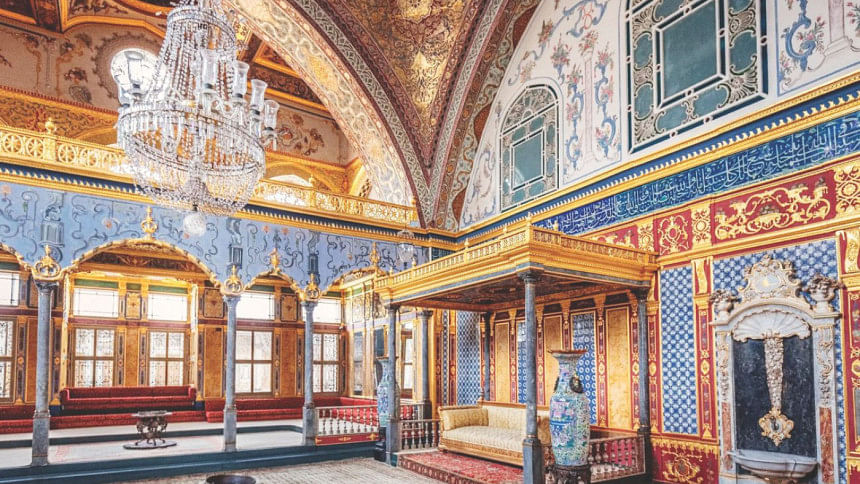The Shadowy Shapes of Male Desire

I remember 6-7 years ago, I was telling my cousin Zaima that our family has Arabic ancestry. It took a little while for my six-year-old cousin to process the fact, and ask, "Didi, does that mean we are supposed to wear bikini tops with pretty skirts and do belly dance?" She covered her mouth with the palm of her hand to suggest a veil and began to swing her hips like Shakira. She then thought of her brother who was only one-year-old back then to add, "So Zaraan would lie sideways on a divan right? And we would fan him and feed him with grapes?" I was in fits of laughter, and ever since it has been a source of canned laughter in many of our family addas.
Over the years, I have learned to penetrate through the presumed innocence to realise how stereotypes can colonize our minds. The only interaction with Arabic culture Zaima had was through her Arabic teacher who taught her to read the script without any reflection on the culture. Meanwhile, her young mind had associated Arab culture as one where women were supposed not only to dress and dance sensually but also to serve men. Maybe she picked up the idea from endless viewing of Disney's Aladdin. Disney would never distinguish a Chinese folklore from a Middle-Eastern princess and her associates who resided in palaces or pleasure domes. As an undergraduate student, I now use Edward Said's lens of Orientalism (1978) to understand how the mainstream media offers snippets of historical objects and presents them as objective truth. What really was the condition of women in Asia? Is it possible to go beyond eroticized stereotypes of the Orient? How do we negotiate with such politics of representation when there are many historical evidences to support the Disney claim? This dawned on me while visiting different palaces of the Turkish Sultanates in Istanbul—a place that is known for its East/West history.
In May 2017, I took a three-day trip to Istanbul. It was a city filled with Byzantine architecture, scrumptious food and extremely good looking, well-dressed locals. Due to the Ottoman conquest, many of their churches had been converted to mosques. Hagia Sophia, for instance, has an image of baby Jesus between giant plates containing Islamic calligraphy on one of its walls. Their cuisines tasted Middle Eastern while their streets resembled the ones of Europe. The weather was hot, but somehow my hair didn't frizz nor did my makeup melt. The then twenty-year-old me was mesmerized by this pleasantly paradoxical country.
Through a stroll around the Harem quarters in Topkapi palace, I realized something even more ironic - the word "harem" itself. It has its roots in Arabic, coming from the word haraam (forbidden in Islam). Harem literally is a separate part of the palace, reserved just for women that are not only related to the Sultan, but also his mistresses, concubines and odalisques. Despite the etymological connotations of the word "harem", the Islamic Sultans were notoriously polygamous, enjoying the company of women they were not always married to.
Thanks to Orientalist literature and art, it's hard to picture anything but beautiful, enigmatic women upon hearing the word "harem." Then instantly does my millennial mind go over to sympathize with their lack of freedom. I can't help but wonder how many hashtag "me too" posts would get posted with the availability of internet and social media in their time. However, due to the rich, gilded architecture of the harem quarters, it was easy for me to forget that these women were oppressed. They came from various ethnic backgrounds out of which majority were Caucasian. They were often victims of slave trade or human trafficking. It was also not unusual for their low-income families to sell them off for a life of "luxury" and "comfort."
Just like princesses in fairytales locked in towers, harem quarters were surrounded by high walls to keep the women protected from the outside world. The only "men" to have access into the quarters were eunuchs who guarded the women's living areas. Only castrated men were employed to avoid being "attracted" to the Sultan's relatives and objects of desire. The harem had its own matriarchal hierarchy. The Sultan's legal mother (Valide Sultan) held the highest position. As the senior most member, she was responsible for maintaining peace, order and harmony among the ladies as well as guiding her son on state politics. The Kadins were the Sultan's favorite women who shared the same position and privileges as his legal wife. The odalisques were at the bottom of hierarchy, but if they possessed potentials for concubinage they received the right trainings to be presented to the Sultan.
I learned all these while touring through the Topkapi palace, which now serves as a museum with meticulous documentation of the lifestyles of these women. On the surface it appears extremely glamorous. It even offers baths, a kind of spa service where you are bathed like a harem, an offer I had to politely wiggle out of. However, under the glamour were women who lived a lifetime of objectification and fetishization. Despite getting advantages to exclusive privileges, they lived life of seclusion just for the pleasure of the patriarchy.
But in the grand scheme of human history, this is just one slice of reality. The one who is in power, with agency decides which reality should be preserved or presented not before supplying it with necessary garnishing and seasoning, of course. As viewers we need to be aware of the agency before subscribing to one particular version of history. I guess what I am saying is- considering things with a grain of salt once in a while doesn't hurt!
Arshi Mortuza is currently pursuing her last semester of BA (Hons.) in the Department of English and Humanities at ULAB.

 For all latest news, follow The Daily Star's Google News channel.
For all latest news, follow The Daily Star's Google News channel. 



Comments